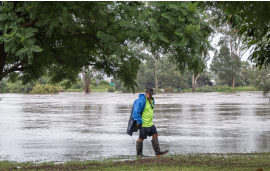Heavy rains can cause localized flooding, fluctuating water levels, swift moving water, landslides, debris flows, and hazardous road conditions.
Knowing the hazards of heavy rain helps minimize potentially dangerous situations.
How to prepare
Keep your gutters clear of debris. Check the storm drains in front of your home and clear away any leaves from the openings. This will enable rain water to get into the storm water system and help to prevent or minimize flooding.
If you live near waterways, stay alert for changing conditions and rising water levels. Creeks can be hazardous since their channels tend to be narrow and they can fill up very quickly.
Creeks and rivers can jump their banks and eroding banks can result in unstable ground.
What to do during heavy rain
Keep yourself, children, and pets away from waterways. Monitor local media for updates.
On the road, drive carefully, slow down, and give yourself more time to get where you are going. If you come upon a flooded street, take an alternate route.
Roads covered with pooled flood waters can be dangerous to drive on.





